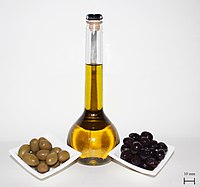
Photo from wikipedia
BACKGROUND Beef from pasture-fed animals is viewed as a healthier and more welfare-friendly alternative to concentrate-fed beef. Botanically-diverse pastures consisting of numerous plant species may alter the fatty acid (FA)… Click to show full abstract
BACKGROUND Beef from pasture-fed animals is viewed as a healthier and more welfare-friendly alternative to concentrate-fed beef. Botanically-diverse pastures consisting of numerous plant species may alter the fatty acid (FA) profile and the tocopherol content of beef, as well as the oxidative stability of the meat. In this study, steers were assigned to one of three botanically-diverse diets: perennial ryegrass (PRG), perennial ryegrass + white clover (PRG+WC), or multi-species (MS), all with a finishing diet of the respective botanically-diverse silages plus a cereal-based concentrate, consistent with production systems in Ireland. The FA profile, tocopherol content, oxidative stability and colour of meat during storage were measured. RESULTS Compared to the other diets, the MS diet resulted in higher proportions of linolenic acid (C18:3n-3c), linoleic acid (C18:2n-6c), and total polyunsaturated fatty acids (PUFA), with higher polyunsaturated: saturated fatty acids (PUFA:SFA) and n-6:n-3 ratios in the meat. α-Tocopherol concentrations were lowest in the meat of animals from the MS diet. In uncooked meat, lipid oxidation and colour values were affected by storage time across all diets, whereas the MS diet only affected hue values on day 14 of storage. When cooked, meat from steers on PRG+WC and MS diets had higher lipid oxidation over day 1 and 2 of storage than meat from steers on the PRG diet. CONCLUSION Feeding steers on a botanically-diverse diet consisting of six plant species can improve the n-3 FA and PUFA concentration of beef, affecting the susceptibility of cooked, but not uncooked, beef to oxidation. This article is protected by copyright. All rights reserved.
Journal Title: Journal of the science of food and agriculture
Year Published: 2023
Link to full text (if available)
Share on Social Media: Sign Up to like & get
recommendations!